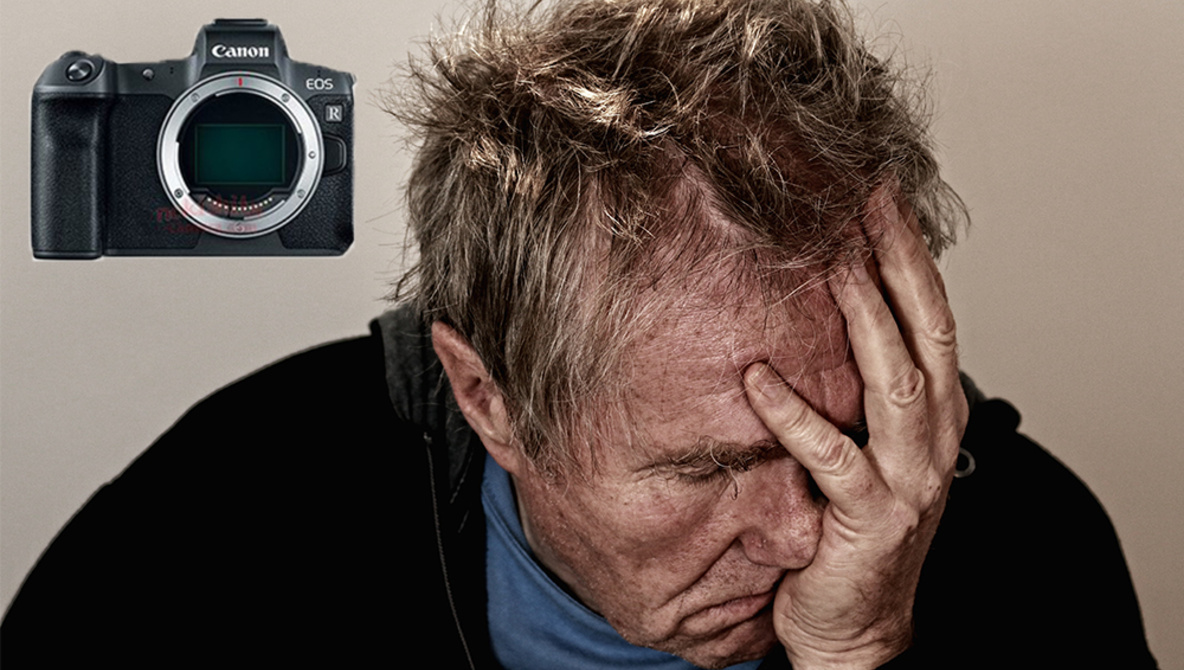
The 5D Mark IV didn’t really impress when it was released two years ago. In the middle of the ongoing mirrorless war, the leaked brochure of the full-frame mirrorless Canon R camera shows what seems to be a simple mirrorless 5D Mark IV.
The race to the bottom continues for Canon. After the boring 5D Mark IV, the stagnant 6D Mark II, and an insipid line of EOS M cameras, we are going to be served with what appears to be a simple derivative of an existing DSLR.
The sensor seems to be recycled from the 5D Mark IV with 30.3mp (30.4mp on the Mark IV), and identical values for the resolution (6720 x 4480), pixel unit, and total number of pixels. While the 5D Mark IV certainly has the best sensor made by Canon, it still lags behind the ones from Sony and Nikon.
IBIS (In-Body Image Stabilization) is missing, which makes sense because two of the four RF lenses are fitted with Image Stabilization (Canon RF 35mm f/1.8 IS STM Macro and the RF 24-105mm f/4L IS USM). Also missing is the second card slot, but at least Canon sticks to the traditional SD card, unlike Nikon, which picked the expensive XQD format for its Z line.
In the video department, the Canon R can record in 4K UHD/30 and 1080p/60, but the amount of crop is unknown at this time. Unfortunately, based on the poor track record of this company regarding video, I fear the worst. The 5D Mark IV came with a 1.7x crop factor in 4K recording, while the fantastic DPAF (Dual Pixel Auto-Focus) was simply disabled on the Canon M50. At least Canon got rid of the inefficient MJPEG codec and the R camera can now record in h.264 at 120 Mbps.
Talking about auto-focus, the brochure indicates an impressive number of AF points with a maximum of 5,655 points. In terms of lens compatibility, the camera can be fitted with EF and EF-S lenses via the adapter, but the EF-M lenses are not compatible. Considering the poor selection of EF-M lenses, they won’t be missed.
Here are some of the main specifications of the Canon R camera:
- Sensor: 30.3 megapixels (6720 x 4480)
- Image format: JPEG, RAW (14 bit Canon original), C-RAW (Canon original)
- Card: 1 slot, SD/SDHC/SDXC
- EVF: OLED color electronic viewfinder, 23mm eyepoint, 0.71x/33.3° magnification
- Autofocus: Max. 5,655 when selected with cross keys. EV -6 to 18 (f/1.2, at 73°F/23°C, ISO 100, One-Shot AF)
- Metering range: EV -3–20
- ISO sensitivity: 100 to 40,000 (extended ISO: 50, 51,200, 102,400)
- Maximum shutter speed: 1/8000 s
- High-speed continuous shooting: 8 fps (5 fps at servo AF)
- Video: 4K/30 and 1080/60, crop and video features unknown
- Codec and bitrate: MPEG-4 AVC (480 Mbps) and h.264 (120 Mbps)
- LCD monitor: 2.15 millions dots, articulated flip screen, 100 percent coverage, 3.15 in./8.01 cm diagonal (2.63 in./6.67 cm width, 1.75 in./4.44 cm height)
- Battery: LP-E6N, 370 shots CIPA rating (450 with power saving)
- Weight: 660 g (including battery / memory card), 580 g (body only)
- Size: 135.8 x 98.3 x 84.4 mm
To be fair, this camera will take nice pictures and sell like hot cakes. Canon products are extremely solid performers. Lovely colors, legendary reliability, good weather sealing, perfect ergonomics, and flawless customer service are part of the equation. Specifications are not everything, but I personally think that Canon missed another opportunity to be competitive. The Canon R system only demonstrates that this brand is not willing to give us anything more than they are forced to. In this case, Sony, Fuji, and the Micro Four Thirds cameras are what forced Canon to release a full-frame mirrorless product. Will it be enough to convince people not to switch to Sony and Panasonic? Personally, I find the Canon response quite pathetic. At this point, I would recommend to anyone to wait and see what other manufacturers are going to announce this month. Panasonic is expected to unveil its own full-frame mirrorless system on September 25, while Sony should introduce a new a7S III soon.

